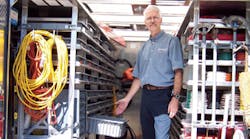John Hucker prefers predictability when it comes to stocking his residential service trucks. Take a look inside his aerial truck or any one of his eight box trucks and you'll find the exact same number of parts, right down to the wire connectors. It's not that he dislikes individuality, but by maintaining a mandatory, fleet-wide truck inventory system, he's never more than a few mouse clicks away from knowing exactly how much material he has on hand.
That level of organization isn't just about being able to account for everything all the time, though. Hucker will rotate apprentices from one technician to another from time to time, and the inventory template approach makes it easier for them to adjust to a new truck. Most importantly, though, it helps the technicians themselves. “[Without an inventory system] they're guessing whether they can tell the customer if they can do the job or not,” Hucker says. “But with a system like this in place, they know what they have and what they can do.”
Send in the clones. Hucker was inspired to develop his inventory system almost seven years ago after seeing one of service industry guru George Brazil's trucks at a plumbing seminar. With its two rows of shelving units that housed pull-out trays divided into several compartments, Brazil's storage layout was a revelation (“Stocking Stuffers” below). But because it was designed for a plumbing company, it only took Hucker halfway; he still had to adjust the system to meet his electrical needs.
With Brazil's tray method as a foundation, Hucker started his own system by determining what materials his technicians would need to serve their customers on any given day. A review of old invoices gave him a good idea of what he'd need, but it was his technicians who solidified the list. “They're the ones doing the work,” he says. “For me to sit there and tell them they needed something if they thought they didn't would have been foolish.”
Once he chose what parts to stock, he had to decide how many. Again, the invoices helped him rough out his list, but his decision to restock daily allowed him to pinpoint a number. Because his technicians only needed enough parts to get them through one day — possibly two in a pinch — they could carry fewer.
Although Hucker designed the inventory to be rigid from one truck to the next, he decided to be much more flexible with his master list of parts. With the system in place, he's able to more easily track part movement, which means he notices when parts don't turn over as quickly as he might have expected. Quantities for slow sellers are reduced or cut altogether, making way for newer or more popular items.
Deciding where to put each part may have been the most difficult step. Hucker did his best to group similar items — conduit fittings, straps, and pipe nipples go together in one area, hardware goes in another — but weight distribution was a determining factor as well. After settling on quantities, he filled the 90 trays he figured he'd need, weighed each one separately on a shipping scale, and divided them between the two sides to evenly distribute weight. He considered putting the most commonly used parts toward the back of the truck, but decided that maintaining a logical grouping was more important.
Hucker ordered his trucks with shelves installed, and just slid in the trays when they arrived. But, he points out, that's not the only way to go. “I didn't have to pay somebody to become a carpenter or try to figure out how to make metal shelves work in there,” he says. “But the main thing is designing shelving units that you can easily duplicate from one truck to the next.”
The inventory system has significantly reduced the time it takes to prep new trucks for service. Hucker used to assign one of his electricians for at least 40 man hours just to pull parts. Now he can pay a young helper to load the trays in a day or two, and the truck can be stocked, painted, and on the street in a week.
Getting the truck stocked is only half of the equation, though. Sticking to the system is the other. “If you do all of this work and then you don't track the movement of the parts, your technicians are going to run out of parts and lose confidence in their ability to do the work,” Hucker says. “And that defeats the whole system.”
Sidebar: Stocking Stuffers
Hucker's plastic trays are the heart of his inventory system. They're 16 inches by 20 inches and can be divided into anywhere from 16 to 20 compartments. But it's the labels that make them work.
-
Narrowing the search — The one-inch-by-three-inch adhesive labels have all the information a tech needs to find what he's looking for: a description, part number, and manufacturer name.
-
Simplifying restocking — The labels are also printed with a picture and the number of parts that should be stocked, making it easier for part-time help to replenish the supply. “If there's a difference between the picture and what's in the bin, my warehouse person knows there's a problem.”





